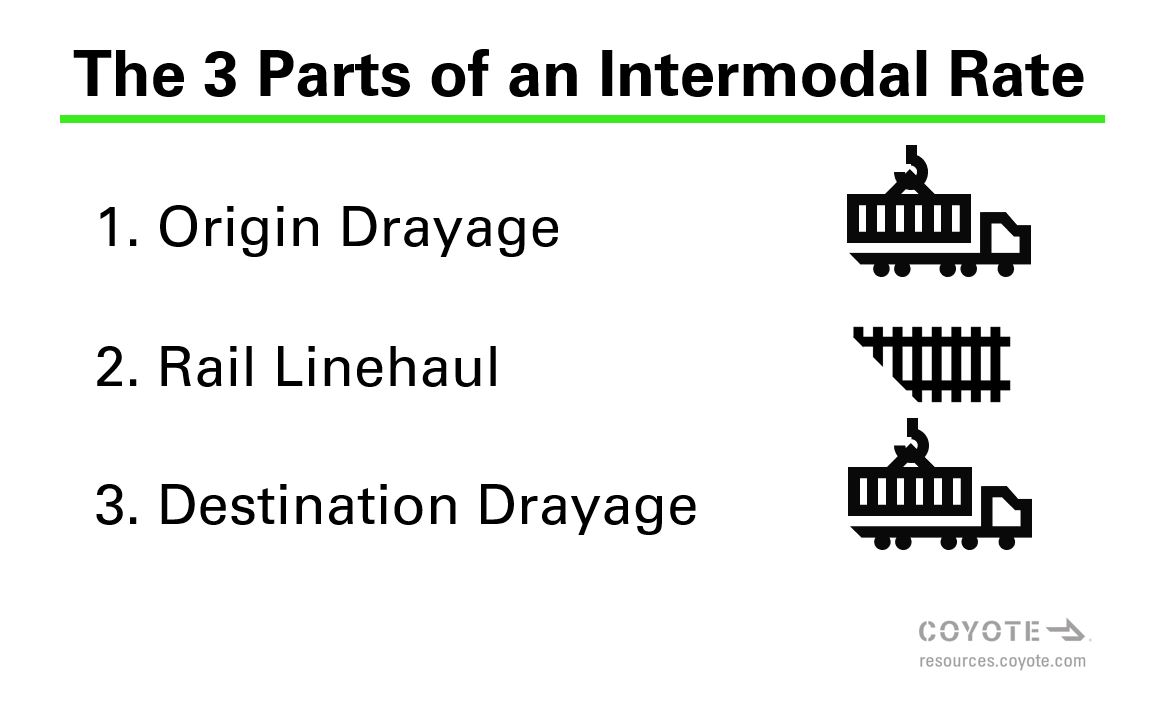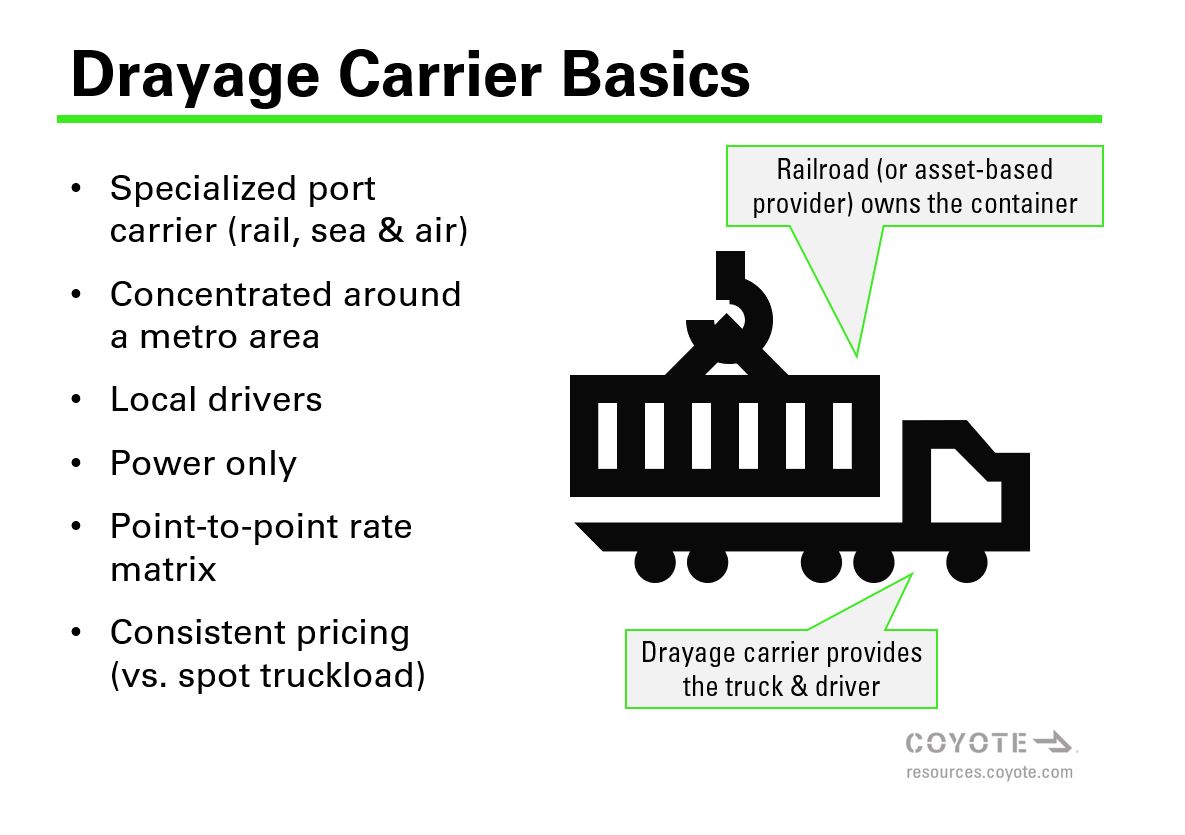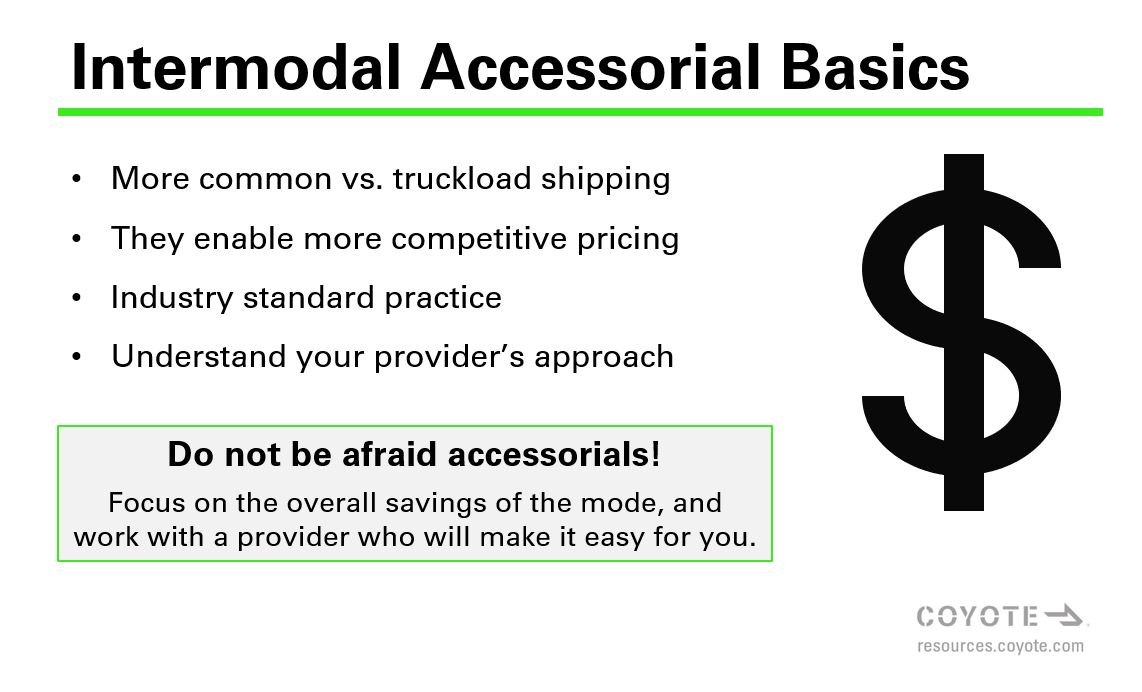3 Types of Intermodal Pricing Every Shipper Should Know
Article Overview
- 3 Parts of an Intermodal Rate
- Drayage Pricing Basics
- Rail Pricing Basics
- 3 Types of Intermodal Rates
- Accessorial Overview
- Key Points
- Working with a 3rd Party
Every truckload shipper should have intermodal as a part of their strategy.
In additional to the sustainability of intermodal, it provides cost-savings and predictable pricing.
But how many shippers understand what actually goes into an intermodal rate?
While getting an intermodal rate from a reliable intermodal provider is straightforward (they take care of everything), having a better understanding of what goes into pricing will make you a more confident and knowledgeable intermodal shipper.
We break down some of the nuances of this particular mode to help you better integrate intermodal into your overall shipping strategy.
A basic understanding of what goes into pricing will make you a more confident intermodal shipper.
The 3 Parts of an Intermodal Rate
An intermodal rate has three basic components: an origin drayage rate (trucking company), a rail linehaul (railroad) and a destination drayage rate (trucking company).
This is true for both asset and non-asset intermodal providers (IMCs).
They key difference is that asset providers own the actual container being transported and also own the origin and/or destination drayage operations (though not always).
The Basics of Drayage Pricing
What Is a Drayage Carrier?
Drayage carriers, also called draymen, are specialized motor carriers that operate in-and-out of railroad facilities (and depending on location, seaports as well).
Drayage drivers are often local and typically complete multiple loads a day within their respective metro region.
Drayage carriers are power only, meaning they supply only the truck (i.e. the tractor or power unit) and will pick up and drop off equipment (i.e. the container and chassis) owned by either the railroad, an asset-based intermodal provider or an international maritime organization (i.e. ocean freight liners).
Related: Check out the Drayage Carrier Deep Dive
Drayage Rates
Since drayage carriers start and/or end every load at a consistent location (the intermodal rail ramp), they can offer consistent rates.
Rates are provided as a flat rate, plus a fuel surcharge to account for fluctuations in diesel.
Draymen typically provide a point-to-point rate matrix, which includes pick-up and delivery rates from every intermodal ramp in the metro region to dozens of towns and cities in the region.
Some carriers can handle drayage up to 300 miles but hauls of 50-100 miles are most common.
Drayage rates are much less volatile than truckload spot market rates. Drayage carriers will often update their rate matrix only once per year (sometimes less), compared to truckload spot rates, which fluctuate daily to account for current supply and demand.
For higher-volume, consistent opportunities, drayage carriers negotiate special rates for committed freight.
Drayage rates are much less volatile than truckload spot market rates.
Do I Need To Get Drayage Rates?
It depends.
If you are shipping domestic intermodal freight in a 53′ container, you will rarely (if ever) deal with the underlying drayage carriers.
You will get “door-to-door” service, where your intermodal provider will handle all your drayage, including pricing, choosing the right carrier, negotiating rates, and operations.
If you are shipping international freight, especially coming into a port, you may need to arrange your own container drayage.
The Basics of Intermodal Rail Rates
This is the portion that most people associate with intermodal: the railroad.
There are seven Class I railroads in North America where your intermodal freight could travel, depending on where you are shipping:
| Railroad | Primary Area of Operation |
| Union Pacific | Western U.S. |
| BNSF | Western U.S. |
| CSX | Eastern U.S. |
| Norfolk Southern | Eastern U.S. |
| Canadian Pacific | Canada & Northern U.S. |
| Canadian National | Canada & Northern U.S. |
| Kansas City Southern | South Central U.S. & Mexico |
Intermodal providers get pricing matrices from the railroads.
Each railroad will provide rates from their intermodal ramps to other intermodal ramps, both within their network and for other rail networks outside their area of service.
Rail linehaul rates are comprised of a flat fee plus a fuel surcharge.
Though there is a dense network of intermodal coverage across North America, not all intermodal ramps connect to each other (i.e. offer pricing and service), even within the same railroad’s network.
3 Types of Intermodal Rail Rates
Intermodal rail networks involve massive amounts of equipment on fixed tracks.
Railroads must prioritize network balance — if their containers and trains are not where they need to be when they need to be there, service will suffer.
To maintain balance, railroads use a few different pricing structures to stimulate traffic flow in various lanes and corridors.
The most common types of intermodal rail rates include:
- Spot rates
- Contract rates
- Project rates
Keep in mind: all these rates are only accessible to intermodal providers (asset or non-asset) and shippers cannot get them directly.
1. Intermodal Spot Rates
Sometimes called FAK rates (freight all kinds), these are the most common.
Since intermodal is a truckload conversion product, railroads are cognizant of what is happening in the truckload market and factor those trends into their intermodal spot rates.
Though they do fluctuate in response to market demands, compared to truckload pricing these rates are more stable and do not change much (if at all) from week to week.
Intermodal Peak Season: The Exception to the Rule
There is one notable exception: intermodal peak season off of the West Coast.
As imports (namely from China) come into ports in California (and Oregon and Washington to a lesser extent) for the upcoming holiday season, the Union Pacific and the BNSF railroads have a huge surge in outbound demand.
Intermodal peak season typically begins in September and runs into December.
As capacity tightens, spot rates out of these regions will increase several hundred dollars per lane.
Peak season aside, intermodal spot rates are relatively stable, and unless a railroad makes a significant network change, adjustments tend to be incremental.
Intermodal spot rates are relatively consistent, with peak season out of the West Coast in Q3/Q4 being a notable exception.
2. Intermodal Contract Rates
These are shipper-specific rates that railroads create during annual bids (aka RFPs). They are commonly referred to as SPQs (special price quotes).
Here’s how the intermodal bid process usually works:
- The shipper releases their bid to intermodal providers.
- The intermodal providers will, independently, go to the rail on behalf of the shipper, prove they were invited to the bid, and ask for special rates on the shipper’s network.
- The railroad creates customer-specific pricing for the requested lanes and returns them to the intermodal providers.
- The intermodal providers will factor in their drayage costs and projected margin, taking into consideration their own network, and submit the total rates into the bid.
- Once the shipper awards the freight, the intermodal provider(s) will confirm with the railroads and get access to the special rates.
Intermodal contract rates are stable and will not change throughout the year. The stability of annual intermodal pricing allows shippers to create dependable transportation budgets.
You don’t necessarily need a ton of volume to get a secure rate — sometimes as little as a few loads a month in a lane is enough.
If you have an opportunity, just ask your intermodal provider.
3. Project Rates
You don’t need to have an annual bid to secure committed pricing from the railroad.
Railroads are always hunting for truckload conversion opportunities, and special projects are a great way to do it.
Project rates are a hybrid of spot and contract rates, which assign a fixed rate for a shorter period of time.
If you have an opportunity where you are moving a bunch of loads over the course of a few weeks or months and want to see if intermodal conversion is an option, ask your provider.
Intermodal Accessorials & Pricing
Why Accessorials Are More Common in Intermodal
Generally speaking, accessorials are much more common in intermodal than in full truckload shipping.
Why? Since the success of this mode depends on efficiency, anything that causes a delay or a diversion may be accompanied by accessorial fees.
Intermodal pricing is very predictable — especially when it comes to contract rates. For this reason, pricing tends to be very competitive, operating on thin margins.
To maximize savings, intermodal providers present shippers with the most efficient pricing, with the expectation that they will be compensated for certain accessorials if and when they occur.
How to Approach Accessorials with Your Intermodal Provider
Make sure you understand your provider’s accessorial policy and find out how they factor accessorial fees are into their rates.
For instance, most providers assume a few days of per diem (aka container demurrage, which is a container leasing fee), and include them in your rate, but you should verify exactly how that is built in your pricing.
Though accessorials are more common in intermodal, there is no need to fear the mode. They are an industry standard and a part of the process.
The key is to remember that, as a whole, intermodal shipping will bring your transportation budget huge cost savings over time.
Though accessorials are more common in intermodal, there is not need to fear — the overall cost savings of the mode are well worth it.
Talking Like an Intermodal Pricing Expert
While intermodal pricing can be more complex than full truckload (or even less-than-truckload), a good intermodal provider will make it easy.
Though you won’t have to have to directly handle all these details, having this foundation will make you much savvier the next time you convert a lane from the highway to the rail or run an intermodal RFP.
Intermodal Pricing: Key Points to Remember
- Intermodal rates are made up of the drayage origin rate, rail linehaul and drayage destination rate.
- Shippers cannot access intermodal rates from the railroads, and must work with a provider, whether asset-based, non-asset-based or a combination of both.
- There are seven Class I railroads and each publishes pricing matrices with rates to intermodal ramps across both their network and into others outside of their region.
- The three main types of intermodal rates are spot rates, contract rates and project rates.
- To provide the most competitive pricing, accessorials are more common in intermodal, but the overall cost savings compared to truckload is significant.
Working With a 3rd-Party Provider
You’re not in this alone.
According to over 500 shippers in our research on supply chain outsourcing, 83% of shippers think using 3PLs is the ideal approach for at least some of their intermodal freight.
65% prefer 3PLs for over half of their intermodal shipments.
Whether it’s a spot rate, a special project or an annual bid, your intermodal provider should take care of the details and make the process simple.
Get more insights like this in the full supply chain outsourcing research study.
Need Help Integrating Intermodal into Your Strategy?
Coyote can expand your reach through flexible, scalable intermodal solutions.
Learn more about our intermodal freight solutions.








